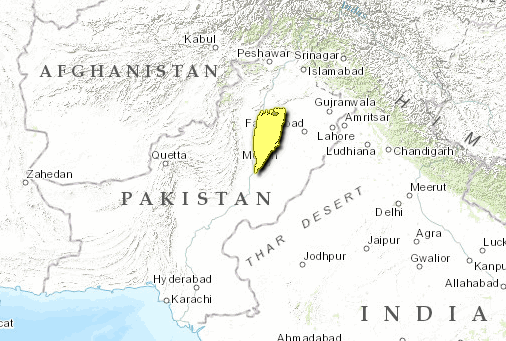Indus Valley desert
The Indus Valley Desert, like the larger Thar Desert, is one of the most inhospitable ecoregions in the Indo-Pacific region. Biodiversity conservation should focus on the large mammals and birds of the region.
Location and General Description
 Source WWF This arid ecoregion is located in Pakistan's Indus Valley. The foothills of the Glaiman Range and the Chenab River define its western and eastern limits, respectively.
Source WWF This arid ecoregion is located in Pakistan's Indus Valley. The foothills of the Glaiman Range and the Chenab River define its western and eastern limits, respectively.
The extreme annual temperature variations can range from near-freezing in the winter to highs of more than 45 oC during the summer. Annual rainfall averages from 640 to 760 millimeters, which is slightly more than in the Thar Desert.
The vegetation is greatly influenced by the extreme climatic regime. The desert thorn scrub vegetation is characterized by isolated clumps of Prosopis spp., Salvadora oleoides and Caparis spp., and taller thorn-scrub forests of Acacia spp., Tamarix spp., Albizzia lebbek, and Morus alba.
Biodiversity Features
This desert ecoregion is not high in richness or endemism, but it does harbor a few large vertebrates that can serve as focal species for conservation. These include the wolf (Canis lupus), hyena (Hyaena hyaena), caracal (Felis caracal), leopard (Panthera pardus), and Punjab urial (Ovis orientalis punjabensis). The overall mammal fauna consists of thirty-two species, but none are endemic to the ecoregion.
Bird richness is higher, with 190 species, but none are considered endemic species.
Current Status
The single protected area covers more than 13,000 square kilometers (km2), or almost 70 percent of the ecoregion area (Table 1).
Types and Severity of Threats
|
Table 1. WCMC (1997) Protected Areas that Overlap with the Ecoregion. Protected Area Area (km2) IUCN Category Thal 13,290 UA Ecoregion numbers of protected areas that overlap with additional ecoregions are listed in brac Because the harsh climate is unsuited for settlement, agriculture (Indus Valley desert) , and livestock grazing, direct human threats are not as significant as in other ecoregions. Justification of Ecoregion DelineationMacKinnon placed the deserts of northwestern India and Pakistan into four subunits (I3a-d). We reclassified these subunits into eight ecoregions based on the extent of distinctive habitat of regional spatial scales. Using MacKinnon's biounit framework and his digital map of original habitat, we delineated the desert habitat in subunit I3c as the Indus Valley Desert. Both the Rann of Kutch seasonal salt marsh and the Indus Valley Desert lie within Udvardy's Thar Desert biogeographic province. Additional Information on this Ecoregion
Further Reading
| |||
